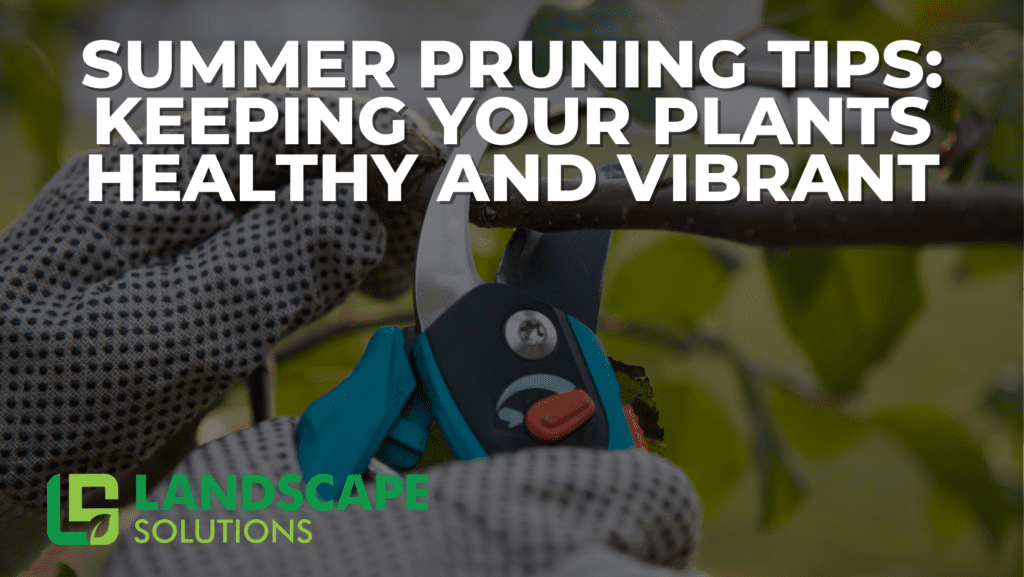
Pruning might seem counterintuitive to some gardeners. After all, it involves cutting back the very growth that signifies a thriving garden. However, proper pruning is essential for maintaining the health, appearance, and productivity of your plants. Summer pruning, in particular, plays a critical role in ensuring your garden remains vibrant and robust. Here’s a detailed guide to summer pruning, brought to you by Landscape Solutions.
Why Prune?
Pruning is not just about cutting off parts of a plant; it’s about encouraging healthy growth and improving the plant’s overall structure. A well-pruned plant will have better air circulation, more sunlight reaching its leaves, and a stronger framework to support its growth. Pruning also helps manage the size and shape of the plant, ensuring it fits well within your garden’s design.
Key Benefits of Pruning:
- Encourages New Growth: Pruning stimulates the plant to produce new growth, which is often more vigorous and healthy.
- Improves Plant Health: Removing dead, dying, or diseased parts of the plant helps prevent the spread of diseases and pests.
- Enhances Flower and Fruit Production: Proper pruning can increase the quantity and quality of flowers and fruits.
- Maintains Desired Shape: Regular pruning helps in maintaining the plant’s desired shape and size, contributing to the aesthetic appeal of your garden.
Basic Pruning Guidelines
Understanding when and how to prune different types of plants is crucial for effective garden maintenance.
Timing
– Flowering Plants: If a plant flowers between late summer and Christmas, prune it the following spring. For plants that flower from Christmas to late summer, prune them right after they finish flowering.
– Non-Flowering Shrubs: Early spring, before new growth emerges, is typically the best time for pruning non-flowering shrubs.
The Four D’s:
Regardless of the plant type, always prioritize removing branches or stems that are:
- Dead
- Dying
- Damaged
- Diseased
Summer Pruning Techniques
Summer pruning is particularly beneficial for controlling the growth and improving the health of many plants. Here are some specific techniques and tips for summer pruning:
Training Young Plants
Early pruning helps in shaping young plants and developing a strong framework. Decide the shape you want your plant to take and prune accordingly. For example, if you want a tree to have a single, tall trunk, remove any competing stems early on.
Balancing Growth
As plants mature, some areas may grow more vigorously than others. Pruning can help balance this growth. Deadheading, or removing spent flowers, is a common practice. It prevents the plant from putting energy into seed production and instead directs it towards new growth and further blooming.
Controlling Flower and Fruit Quality
Pruning can influence both the quantity and quality of flowers and fruits. For example, cutting back butterfly bush spikes as they start to fade can encourage the next set of blooms to be more vibrant. Similarly, thinning out the branches of a crabapple tree can lead to better fruit production.
Creating a Pattern of Growth
Regular pruning helps maintain the desired growth pattern of plants. Hedges, for example, require consistent trimming to keep their shape. Pruning ornamental plants like dogwood to the ground level each year can encourage brightly-colored new growth.
Maintaining Plant Health
Pruning for health involves removing overgrown areas to allow better air circulation and sunlight penetration. This practice reduces the risk of fungal diseases and pest infestations. Ensuring wide crotch angles between branches can also help plants withstand the weight of snow and ice.
Restricting Growth
Sometimes, it’s necessary to prune plants to prevent them from outgrowing their space. This can be especially true for vigorous species. Pruning can keep these plants manageable and aesthetically pleasing.
Remedial Pruning
For plants that have been neglected or have grown out of control, remedial pruning can help restore their shape and health. This often involves cutting back significant portions of the plant. While drastic, this can stimulate new growth and rejuvenate the plant.
Tips for Effective Summer Pruning
- Observe Before You Cut: Spend time observing the plant’s natural growth patterns and health before making any cuts. This will help you make more informed pruning decisions.
- Use Sharp Tools: Ensure your pruning tools are sharp and clean to make precise cuts and prevent the spread of disease.
- Prune at the Right Time: Avoid pruning during extreme heat or drought conditions, as this can stress the plant.
- Don’t Over-Prune: While pruning is beneficial, over-pruning can harm the plant. Aim to remove no more than one-third of the plant’s total growth at any time.
- Feed After Pruning: Consider feeding your plants after a pruning session to help them recover and thrive.
Proper pruning is essential for maintaining a healthy and vibrant garden, especially during the summer months. If you need expert assistance or advice on pruning and other landscaping needs, contact Landscape Solutions at (615) 852-5009 or visit our website. Our team of professionals is ready to help you keep your garden in top shape year-round.
By following these summer pruning tips, you can ensure that your plants remain healthy, vibrant, and beautiful. Happy gardening!



